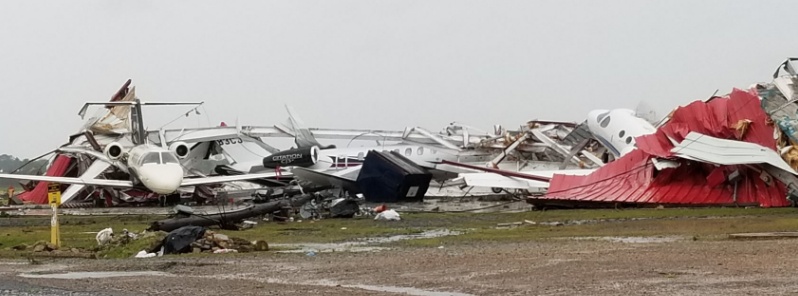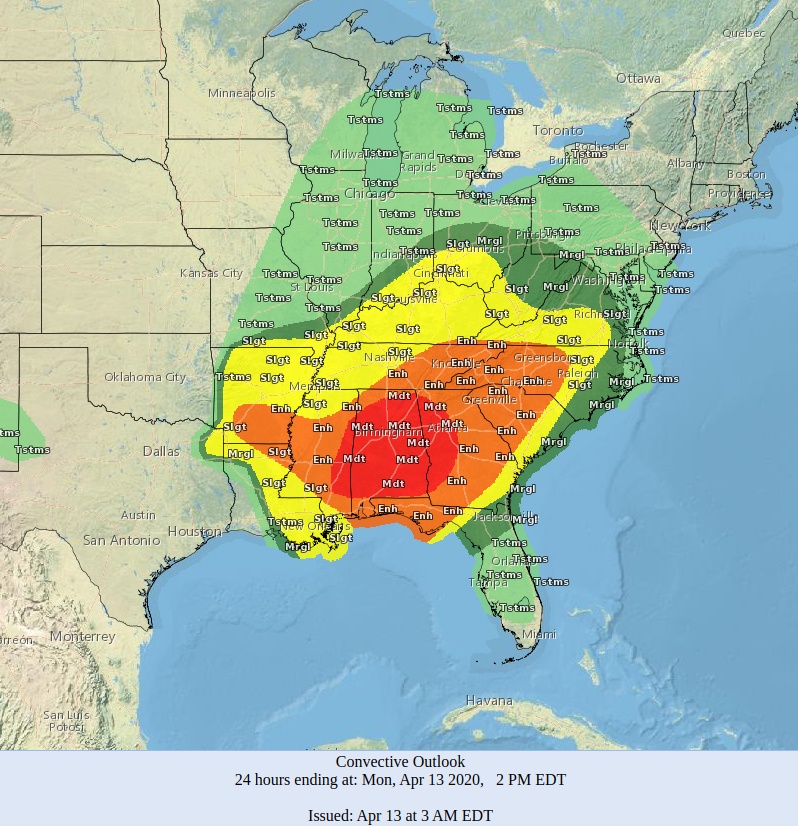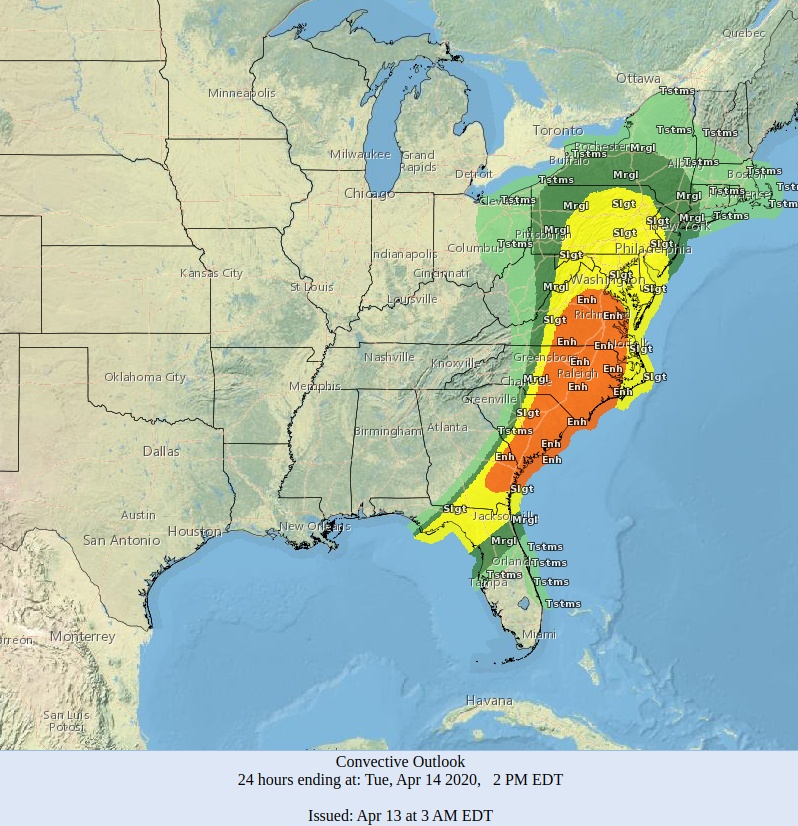Severe weather outbreak: Deadly tornadoes strike the U.S. South, storms shifting toward the Southeast and Mid-Atlantic

A multi-day severe weather outbreak continues across the U.S. South, with destructive tornadoes, heavy rain, hail, and strong winds. The potent storm system is moving northeastward through Monday, causing a variety of weather hazards. At least 33 people have been killed, as of 08:00 UTC on April 14, 2020.
Numerous homes were destroyed and at least 11 people have been killed after destructive tornadoes touched down in Mississippi on Easter Sunday, April 12, forcing Gov. Tate Reeves to declare a state of emergency.
"This is not how anyone wants to celebrate Easter Sunday. The state and our first responders are working around the clock and will not rest until this is over. We are mobilizing all resources available to protect our people and their property," Governor Tate said.
Major damage around Soso, MS. FD reports numerous injuries. Fire crews still trying to clear roads to get to injuries. @weatherchannel #MSwx pic.twitter.com/Nx8Uh2IVAJ
— Charles Peek (@CharlesPeekWX) April 13, 2020
Firefighters having to clear the roads to be able to get back to check for victims near Soso, MS. @weatherchannel #MSwx pic.twitter.com/kcCRqMA7UT
— Charles Peek (@CharlesPeekWX) April 13, 2020
The vicious storms that have produced the tornadoes during the past hour #mswx pic.twitter.com/1UzxH0W80E
— Stu Ostro (@StuOstro) April 12, 2020









A state of emergency was also declared in Alabama and in Louisiana, after significant damage in Monroe, where about 300 homes were damaged or destroyed. While there were no immediate reports of major injuries, the damage is catastrophic.
"The images and reports of major tornado damage in the Monroe area are heartbreaking, and my prayers are with the people there. We are in contact with local officials in the area to provide support," Gov. John Bel Edwards said.
Monroe Regional Airport suffered extensive damage, forcing the cancelation of all flights until further notice. Airport director Ron Phillips estimated there was 25 to 30 million USD worth of damage to the planes in heavily damaged hangar owned by AVFlight.
LOUISIANA SEVERE WEATHER: A lot of structural damage being reported across Monroe from today’s severe weather. This is from a subdivision on Parkland Street. The Monroe Regional Airport also structural damage.
Video courtesy of @gift_of_fofo pic.twitter.com/WyEh0eLVQ2
— Perry Robinson, III (@ThePRobReport) April 12, 2020
Back-to-back tornadoes moving across the same area!? These radar signatures are terrifying. Thinking of Southern #Mississippi today and everyone in the path of these particularly dangerous storms. #mswx @CNNweather @cnnbrk @cnn pic.twitter.com/9Pdt80AxJK
— Derek Van Dam (@VanDamCNN) April 12, 2020
“By the grace of God, early reports show only a few minor injuries. Pray for our city! Many neighbors & friends suffered catastrophic damage. We are hurting; but not broken. Times like this remind us WE ARE STRONGER TOGETHER! Together we we will rebuild.“ – Mayor Jamie Mayo pic.twitter.com/sByzavTiTg
— City of Monroe, LA (@CityofMonroe) April 12, 2020
Due to weather conditions and debris removal from the runways, Mayor Jamie Mayo and Monroe Regional Airport Director Ron Phillips announce “all flights at the Monroe Regional Airport are cancelled until further notice.” pic.twitter.com/Kw4zWNRtZT
— City of Monroe, LA (@CityofMonroe) April 12, 2020


Seven people were killed early Monday (LT) when storms tore through a mobile home park in Georgia.
Three people were killed in Tennessee.
Nine people were killed in South Carolina, including 5 in the city of Seneca. A person in Atalanta was reportedly killed after a tree fell onto a home. Another fatality was reported in Arkansas — the person died after a tree fell on a home in White Hall, Jefferson County, Arkansas.
In total, the Storm Prediction Center received 50 tornado reports from Texas, Louisiana, Mississippi and Georgia on April 12.
More than 560 000 customers are without power — 165 000 in Alabama, 138 000 in Arkansas, 91 000 in Georgia, 87 000 in Texas and 79 000 in Mississippi, according to the PowerOutage.US at 06:24 UTC on April 13.
The number of customers without power rose to more than 1.2 million 11:00 UTC and dropped to 950 000 by 13:00 UTC — 284 000 in North Carolina, 283 000 in South Carolina, 142 000 in Arkansas, 128 000 in Georgia and 110 000 in Alabama.
This dangerous weather system will continue moving northeastward through Monday, April 13, causing a variety of weather hazards.
On the southern side, widespread thunderstorms are likely, and the atmospheric conditions are expected to be favorable for severe weather for the Lower Mississippi Valley, Tennessee Valley, and Southeast into Monday. Tornadoes, hail, and high winds are all potential severe threats, NWS forecaster Tate noted.
As rain amounts could exceed 50 mm (2 inches) in some locations, and there is the potential for training (storms repeating over the same location), flash flooding is another hazard just north of the highest severe weather threat, in the Tennessee Valley toward the Southern Appalachians.
Moderate Risks of both severe weather and flash flooding are in place through tonight. As the cold fronts sweep eastward toward the Eastern Seaboard, severe weather is once again a threat on Monday especially ahead of the initial cold front–an Enhanced Risk of severe weather has been outlooked for portions of the Southeast to Mid-Atlantic.
There could be isolated incidents of flash flooding in the Mid-Atlantic to Northeast, but rain and storms should be fast-moving, so the flooding threat should not be as widespread on Monday.




Images courtesy: NWS
Featured image: Tornado damage at Monroe Regional Airport on April 12, 2020. Credit: The City of Monroe

Stay at home….. yeah, right! Another manufactured storm system. Question is… who keeps on sending the US these formations? Military or somewhere offshore?too hard to believe this constant damaging weather, ice, rain, heat, then this. I just hope people were able to shelter, the worst seem to come at night.Te3rrifying.
The geodynamo determines the path of the magnetic poles and THE INCREASE OF COSMIC-SOLAR RADIATIONS is regulated by the height profile of the magnetic poles with repercussion on global warming and geographical climate changes.
IT IS THE INCREASE OF COSMIC-SOLAR RADIATIONS. Just like all geological and climate events, the increase in the number and intensity of tornadoes is the result of the increase in cosmic-solar radiations that reach the atmosphere, the surface and the core of our planet. Kelsey Ellis, there is no link between the increase of tornadoes and so-called human-driven changes. The man-made climate is a political dogma and before the end of this year, this fact will be completely obvious to the entire people of the world. “Climate and weather researchers are working to identify a clear link between human-driven changes and tornadoes, though there’s no definitive evidence just yet. Part of the reason is because “outbreak” reporting is prone to errors. “Tornado data are plagued with population bias and reporting issues, especially earlier in the record, so it is hard to say that does not play a role in some of these findings,” says Kelsey Ellis, a hazard climatologist at the University of Tennessee Knoxville.“ https://www.popsci.com/story/environment/tennessee-tornados-climate-safety/